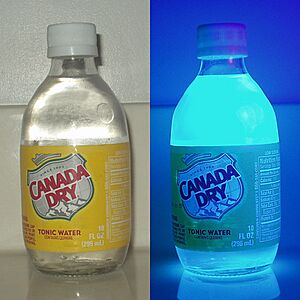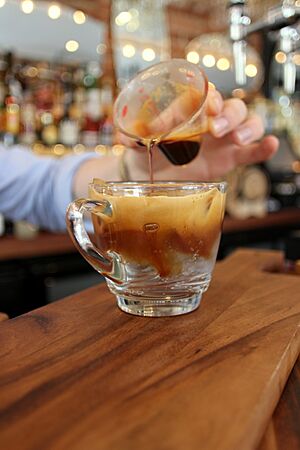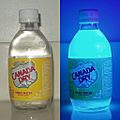Tonic water facts for kids

Tonic water is a bubbly soft drink that has a special ingredient called quinine dissolved in it. Long ago, people used quinine to help prevent a disease called malaria. Today's tonic water has much less quinine and is usually sweeter than the old medicinal kind. People enjoy its unique bitter taste, and it's often used in mixed drinks, especially in the famous gin and tonic.
Contents
The Story of Tonic Water
How Quinine Was Discovered
Way back in the 1600s, in places like Peru, Bolivia, and Ecuador, Indigenous peoples knew about a special remedy. They showed the Spanish how to use quinine from the bark of Cinchona trees to treat malaria. This was a very important discovery!
Tonic Water in British India
In the early 1800s, British officials and soldiers were in India and other warm places that were part of the British Empire. They were told to take quinine to protect themselves from malaria. Quinine tasted very bitter, so they mixed it with soda and sugar to make it taste better. This mix was the very first tonic water!
The First Commercial Tonic Water
The first company to sell tonic water was Pitt & Co. Its owner, Erasmus Bond, got a patent for it in 1858. This meant he officially owned the idea for commercial tonic water.
The Birth of Gin and Tonic
The popular drink gin and tonic also started in British colonial India. British soldiers already had a gin ration. To make their bitter quinine medicine more enjoyable, they mixed it with gin and other things. It was an easy and tasty way to take their medicine! The first time someone wrote about gin and tonic was in 1868. It was described as a refreshing drink for people watching horse races, not just as medicine.
What's Inside Tonic Water?
Quinine Content Today
The very first tonic water had just carbonated water and a lot of quinine. Most modern tonic waters have much less quinine. They often add citrus flavors, which makes them less bitter. They are also usually sweetened with sugar or high-fructose corn syrup. Some companies even make "diet" or "slimline" tonic water, which uses artificial sweeteners like aspartame. If you like a really bitter taste, you can still find traditional tonic water with more quinine, but it's not as common.
Quinine Limits and Safety
In the United States, the US Food and Drug Administration (FDA) sets a limit on how much quinine can be in tonic water. It's about 83 milligrams per liter. This is much less than the amount used to treat malaria, which is usually 500–1000 milligrams per day. So, drinking tonic water won't prevent malaria.
For a while, some people thought quinine could help with leg cramps. However, doctors now say it's important to be careful with quinine doses. The FDA warns people not to use quinine medicines for leg cramps unless a doctor says it's okay, because there can be risks.
How People Use Tonic Water
Popular Drink Mixes
Tonic water is often used to mix with other drinks to create cocktails. If you add lemon or lime juice to tonic water, it's often called bitter lemon or bitter lime. People love it for its special mix of bitter and sweet flavors.
Tonic Water in Coffee
Did you know tonic water can even go in coffee? A drink called the espresso and tonic was invented in Sweden. It started at a coffee shop where staff mixed tonic water, syrup, and an espresso shot. Since 2007, this unique drink has become very popular in Europe and the United States.
How Tonic Water Glows
The Magic of Quinine
The quinine in tonic water has a cool secret: it will fluoresce under ultraviolet light! This means it glows. You can even see quinine glow a little in direct sunlight if the background is dark.
Why Does It Glow?
When ultraviolet light hits the quinine molecules, they absorb energy. Instead of releasing this energy as heat, which is common, they release it as light. This makes them glow! The glow doesn't last forever, though. The molecules eventually return to their normal state and stop glowing.
Images for kids
See also
 In Spanish: Tónica (bebida) para niños
In Spanish: Tónica (bebida) para niños
- Água de Inglaterra




